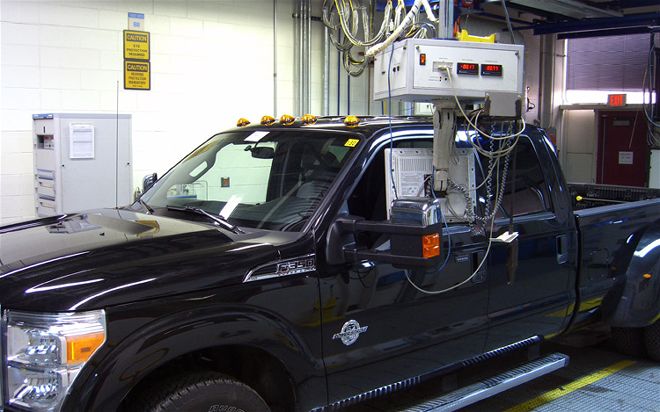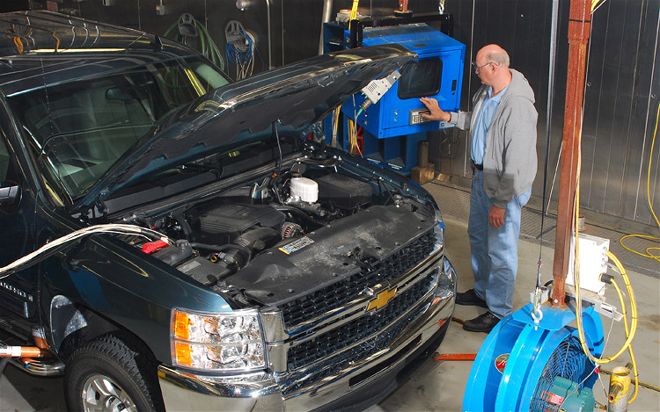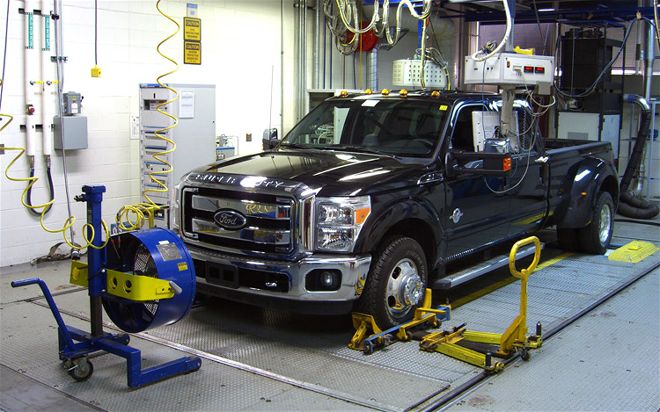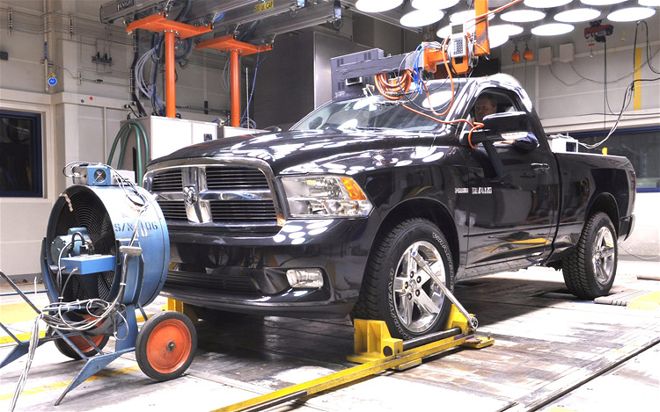As with so many other things, it all started in California in the 1960s. People got tired of palls of brownish smog hanging over otherwise lovely vistas--and breathing air they could see.
State and federal agencies studied the problem and concluded that auto exhaust was primarily to blame. The first hardware-based partial fix, a positive crankcase ventilation valve that routed crankcase fumes into the engine for combustion, was required on new cars sold in California in 1961, then on most vehicles nationwide by 1962.

| 05 Chevrolet Truck Emissions Test Front View
The initial tailpipe emission standards legislated by California for the 1966 model year were followed by national standards for 1968. The regulatory California Air Resources Board was founded in 1967 and the U.S. Environmental Protection Agency in 1970, with congruent missions to tighten tailpipe emissions standards progressively year by year.
The regulated emissions were: (1) hydrocarbons, unburned or partially burned fuel, toxic to humans and a major contributor to smog; (2) carbon monoxide, which replaces oxygen in the blood and can be fatal in large quantities; and (3) oxides of nitrogen, a smog contributor generated when nitrogen in the intake air reacts with oxygen during combustion. Added later were particulate emissions, tiny bits of soot or smoke that can cause respiratory problems in humans and animals, and sulfur oxides from high-sulfur fuel.
By the early 1970s, increasingly tough emissions requirements and add-on technology necessary to meet them had dramatically reduced engine power, smoothness, and efficiency, and still-tougher new ones for 1975 (along with federal fuel-economy standards) seemed all but impossible. Then a team at General Motors (led by future GM CEO Bob Stempel) saved the day with their just-in-time development of the emissions-eating catalytic converter.

| 02 GM Truck Emissions Test Rear View
Since then, increasingly sophisticated catalysts, closed-loop exhaust sensing, electronic engine controls and fuel injection, and an abundance of additional technologies have managed to meet ever-tightening requirements to where today's modern vehicle exhausts are essentially 99 percent pristine. Yet, while CARB and EPA continue to ratchet down tailpipe standards almost annually, the notion that vehicle-emitted carbon dioxide is a factor in climate change has led to a rapid and immensely challenging ramp-up in corporate average fuel economy requirements over the next few years.
Because fuel-economy ratings are derived from the same battery of tests that ensures emissions compliance, we set out to learn what it takes for automakers to accomplish both.
The Process
Dave Garrett, GM's director of emissions compliance and certification, explains that the first step in the incredibly complex process of emissions compliance is to have a full understanding of the regulations. "As new stuff is dreamed up by the regulatory authorities," he says, "we have to understand how those regulations are going to impact the product programs and what the requirements will be during the time frame when that vehicle will be in production.

| 06 GM Emissions Testing Moving
"Right now, for example, we expect California's next round of low-emission vehicle standards, the LEV III program, to begin coming into effect in the 2014 time frame. So any automaker doing a major new-vehicle program for 2012 or 2013 with a life cycle that will extend through 2015-2017 will have to comprehend all the regulatory requirements that are anticipated in those time frames."
Each manufacturer must determine, by model year, specifically what standards it will have to meet, what tests it will need to run, and what the performance levels must be over the life cycle of each vehicle it will build. More often than not, within a couple years after new models are introduced, there will be changes in emissions or fuel economy requirements, "so we have to make our best educated guesses of where those standards will be and provide direction to the program teams," Garrett relates. "We've been doing this for quite a while and have reasonable confidence in being able to forecast where they will be. Also, many requirements are imposed on a fleet average basis, so we have some flexibility."

| 04 GM Emissions Testing Trnsmission
Todd Fagerman, Ford's emissions certification manager, explains that multiple variants in the regulations change as a function of weight class and vehicle type, hence the necessity for representative test groups or sets of vehicles with essentially the same engine and emissions control system. "Once those test groups are established," he says, "our obligation is to identify the worst emissions-performing vehicle within each group and use that configuration to demonstrate that we meet the standards through all the required tests. In essence, for the official certification process, you're testing one vehicle to represent everything that is similar. But within our own internal development process, we need additional data backing up all the other configurations that say we're okay. The development leading up to official certification ensures that the entire product lineup is capable and robust."
Accelerated Durability
Once the engine calibration, development, and validation engineers have done their planning and testing, Garrett points out that "they must understand the full duty cycles of their vehicles. One key input in our certification program is how to age the catalyst. When we submit data to EPA and CARB, we provide low-mileage emissions data and we have to demonstrate compliance at the full 'emissions useful life' of 10 years or 120,000 miles.

| 01 Emissions Testing Computers
"So we have processes and procedures that we've developed over many years to do an accelerated durability program. The key things that deteriorate in an emissions-control system are the catalytic converters and the oxygen sensors, so we determine how those age over that time and mileage...and they age and deteriorate differently in different vehicles, depending mostly on exhaust system temperatures."
People buy trucks to do work. When a truck is working hard, the engine is generating a lot of heat in the exhaust system and the exhaust components age differently from those on a passenger car. So the engineers measure temperatures during real-world operation and take those into account in their accelerated durability programs.

| 02 Ram Truck Emissions Test Front View
"We have to establish what is called a deterioration factor for tailpipe and evaporative emissions," Fagerman continues. "Those tests are done early, starting one to two years out, and take a year or more to complete." The DFs are then applied to low-mileage emissions data to derive the final values that are used in the certification process.
While Chrysler could not provide an interview for this story, Nick Cappa, Chrysler's engineering and technology communications manager, gave us some useful background: "We conduct literally thousands of tests during the course of a development program," he says. "We always target more stringent than the standards to allow for production variation and component aging."
Fuel Economy
While automakers also get their fuel economy measurements from the emissions tests, Rich Bell, Ford's compliance and fuel economy engineering manager, says the test vehicles are not necessarily the same ones used for fuel-economy testing: "There are different configurations, different worst cases, and different requirements. The emissions certification data point is but one of many, so you need to run others as well for the fuel economy label."
"It puts additional complexity on top of the emissions certification process," explains Glen Heiser, Ford's certification test technology manager. "Our emissions certification data is official, so we have to include that for our fuel-economy label. But that's typically the worst-case condition; we also have to represent the highest-volume configurations. We used to do just the city/highway tests for fuel economy, but starting with 2011, all five tests will be baked into the calculations."
In Part II (Truck Trend, July/August), we'll explain the certification tests themselves, the final certification process, and the resources (people and facilities) required for every U.S.-market automaker to get it all done.



